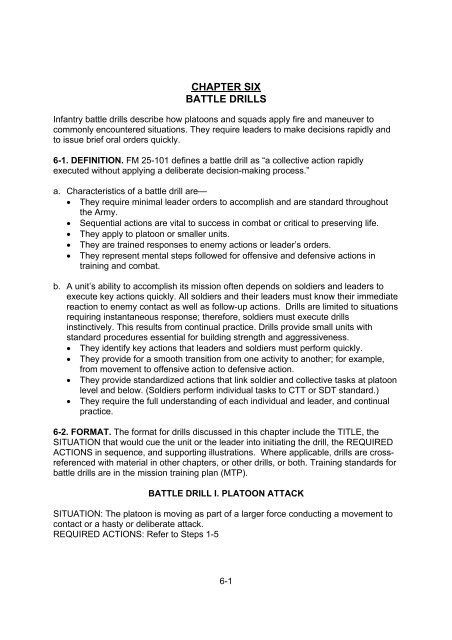You also want an ePaper? Increase the reach of your titles
YUMPU automatically turns print PDFs into web optimized ePapers that Google loves.
CHAPTER SIX<br />
BATTLE DRILLS<br />
Infantry battle drills describe how platoons and squads apply fire and maneuver to<br />
commonly encountered situations. They require leaders to make decisions rapidly and<br />
to issue brief oral orders quickly.<br />
6-1. DEFINITION. FM 25-101 defines a battle drill as “a collective action rapidly<br />
executed without applying a deliberate decision-making process.”<br />
a. Characteristics of a battle drill are—<br />
• They require minimal leader orders to accomplish and are standard throughout<br />
the Army.<br />
• Sequential actions are vital to success in combat or critical to preserving life.<br />
• They apply to platoon or smaller units.<br />
• They are trained responses to enemy actions or leader’s orders.<br />
• They represent mental steps followed for offensive and defensive actions in<br />
training and combat.<br />
b. A unit’s ability to accomplish its mission often depends on soldiers and leaders to<br />
execute key actions quickly. All soldiers and their leaders must know their immediate<br />
reaction to enemy contact as well as follow-up actions. Drills are limited to situations<br />
requiring instantaneous response; therefore, soldiers must execute drills<br />
instinctively. This results from continual practice. Drills provide small units with<br />
standard procedures essential for building strength and aggressiveness.<br />
• They identify key actions that leaders and soldiers must perform quickly.<br />
• They provide for a smooth transition from one activity to another; for example,<br />
from movement to offensive action to defensive action.<br />
• They provide standardized actions that link soldier and collective tasks at platoon<br />
level and below. (Soldiers perform individual tasks to CTT or SDT standard.)<br />
• They require the full understanding of each individual and leader, and continual<br />
practice.<br />
6-2. FORMAT. The format for drills discussed in this chapter include the TITLE, the<br />
SITUATION that would cue the unit or the leader into initiating the drill, the REQUIRED<br />
ACTIONS in sequence, and supporting illustrations. Where applicable, drills are crossreferenced<br />
with material in other chapters, or other drills, or both. Training standards for<br />
battle drills are in the mission training plan (MTP).<br />
BATTLE DRILL I. PLATOON ATTACK<br />
SITUATION: The platoon is moving as part of a larger force conducting a movement to<br />
contact or a hasty or deliberate attack.<br />
REQUIRED ACTIONS: Refer to Steps 1-5<br />
6-1


